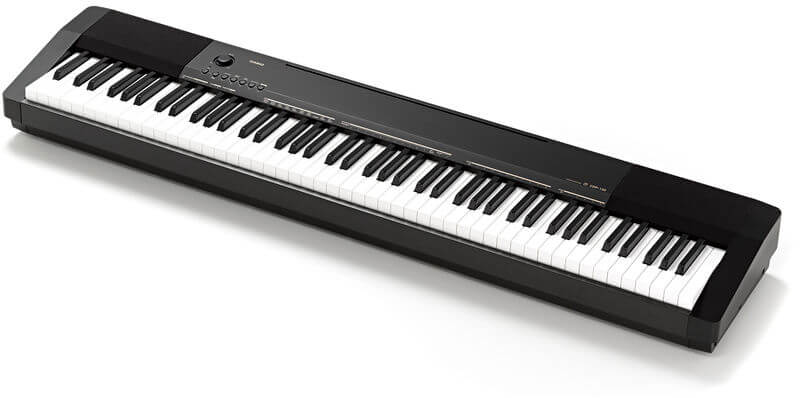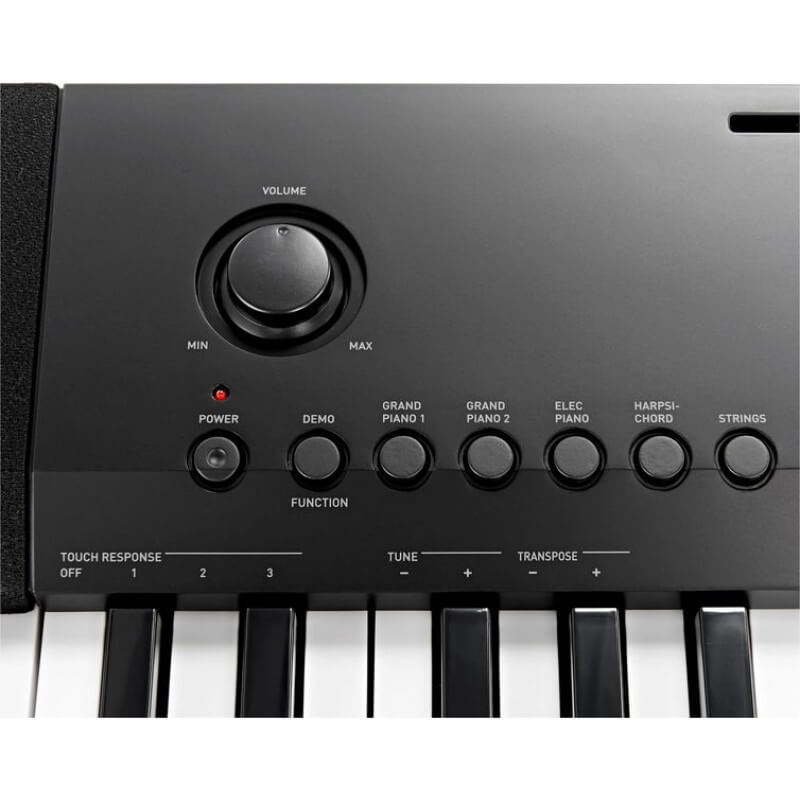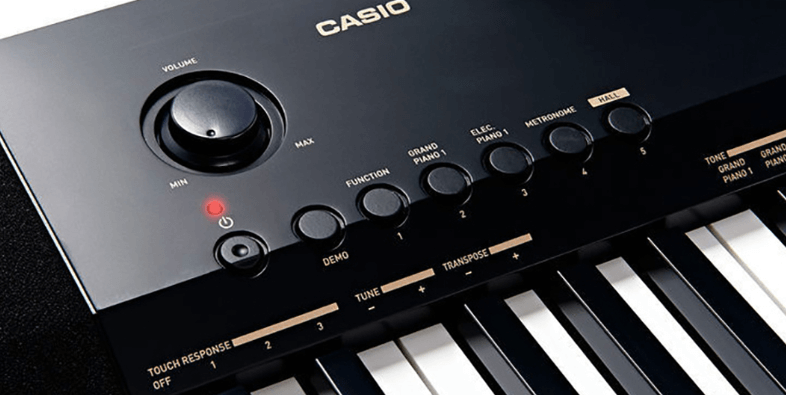Introduction to the Casio CDP 130
On the off chance that you felt a little feeling of history repeating itself while taking a gander at the Casio CDP 130, it is because the suspension is fundamentally indistinguishable from the CDP-120’s. Truth be told, the two pianos have a similar bureau, console and availability choices, so it’s very simple to be befuddled when contrasting the convenient keyboards one next to the other.
The item comes in two distinct completions: the CDP-130BK (dark) and the CDP-130SR (silver), and both renditions can be transformed into a household item by including the coordinating Casio CS-44P stand, accessible independently for $119.
The principal interface of the Casio CDP 130 incorporates a Power catch, a Volume handle, the Demo mode, the multi-utilize Function catch, two catches to choose the Grand Piano or Electric Piano tones, the new Metronome mode (that permits to rehearse with the rhythm) and the redid Reverb segment, which now incorporates a more profound Hall demonstrate that can be helpful to advance the piano sounds.
Other propelled capacities, for example, the Touch Response, the Transpose, the implicit DSP (for changing the Reverb force and the Chorus profundity) and the Metronome Tempo/Beat, can be overseen by squeezing the Function catch and the coveted note on the console.
The top board incorporates the two 8W-oval Full Force Sound Speakers and an opening for putting the music stand, while on the backboard we discover the Headphones yield, the Sustain jack, a USB port for MIDI availability, and the power supply jack.
Features of Casio CDP 130
Click to check price & new edition of CDP 130
First, there is the somewhat realistic stereo grand piano sound which for the price is pretty impressive. Next up is the weighted hammer action which makes the Casio CDP 130 feel like a real piano.
- Five distinct sounds including a stereo excellent piano I and 2, electric piano, harpsichord and strings
- 32-note polyphony (which implies you can play up to 32 notes all the while)
- Eight computerized impacts including varieties of reverb and tune layer and transpose work onboard speaker framework
- MIDI info/yield (awesome for utilizing with your home PC) earphone and manage pedal jacks.
- The Casio CDP 130 computerized piano likewise accompanies a manage foot switch – more on this later in the survey.
Like the old CDP-120, the Casio CDP 130 components the exemplary AHL Sound Source motor, which now offers ten sounds (against the five tones incorporated into the past model) and a similar measure of polyphony, set to a most extreme of 48 notes. This enables clients to play exceptionally complex entries of established music, for example, arpeggios or scales, while squeezing the manage pedal. A similar component can be useful while playing greater harmonies in Layer mode, with no danger of dropped notes.
Likewise coming back from the CDP-120, the 88-key Scaled Hammer-Action Keyboard is an awesome path for understudies to begin taking in the piano nuts and bolts and the significance of flow, on account of a spring-less mallet framework that gives a heavier touch on the lower notes, and a lighter touch on the higher ones, much the same as a genuine fabulous piano.
The capacity to set an alternate key responsiveness (picking between three affectability levels, or notwithstanding debilitating it if you favor the standard touch reaction) is an extraordinary device to legitimately ace the distinctive progression that a great piano can offer when playing milder or louder.
In spite of the passage level idea and the convenient plan of the casio cdp 130, the new advanced piano from Casio offers a sensible ordeal that is awesome for piano understudies and fledglings, as well as for every one of those live artists who need a well-sounding and minimized computerized piano for their gigs, on account of a to a great degree lightweight skeleton (just 23 pounds).
Discretionary Accessories
Since the maintain foot switch is not exceptionally valuable and is an on/off switch – you require a genuine support pedal. I prescribe spending a couple of dollars and moving up to something like the M-Audio SP-2 Sustain Pedal.
Another discretionary adornment that you will need to have is the Casio GSDX Deluxe Keyboard Stand. This will guarantee that you’ll position your advanced piano at the right stature which is basic for agreeable access to the console for the musician.
There are many individuals who might want to play the piano in their homes. Be that as it may, customary acoustic pianos offer numerous downsides. They are enormous, substantial, costly and they leave tune. Rather than an acoustic piano, a conspicuous option is to get a computerized piano. They offer none of these disadvantages in addition to they have extra components like more than one piano tone and earphone attachments for noiseless practice.
If you are an amateur, then there are two evident hopefuls from which to pick. They are the Casio CDP-130 and the Yamaha NP-30. In this article I set out to clarify some of their disparities and their upsides and downsides empowering you to settle on a superior educated choice should you wish to get one.
Console
A standard current piano console has 88 keys (i.e. 7 octaves). The Casio CDP 130 has 88 weighted keys with scaled mallet activity through the NP-30 just has 76 keys with reviewed delicate touch (bring down keys are overwhelming; higher keys are light). The general agreement among players is that the Casio gives the most practical activity and comes nearest to the real feel of playing a genuine piano.
Sound
The CDP-130 has five diverse piano tones onboard while the NP-30 has 10. Both are equipped for delivering a practical amazing piano solid from one of these tones. Moreover, the CDP-130 has five demo melodies while the NP-30 has 10. These melodies are perfect for playing along to pick up practice. The CDP-100 has a 2x 8W speaker framework while the NP-30 has 2x 6W. In spite of this, the NP-30 is viewed as delivering the marginally better quality sound from its speakers.
Transportability and Construction
Both these instruments are amazingly compact because of their lightweight in spite of the fact that the Casio CDP 130 is physically marginally bigger because of its greater console. Stylishly they both look exceptionally alluring. The Casio CDP 130 is done in dark/dim through the NP-30 is accessible in either dark or silver wrap up. Also, the CDP-130 is accessible with a coordinating stand which may make it look more alluring in your home.
Whichever of these consoles you purchase the one thing you will get is the fabulous incentive for cash. Be that as it may, the one you do pick will be the one which suits your necessities best. For the CDP-130 is the 88 note console with its unrivaled authenticity and feel. Then again, the NP-30 offers more installed piano tones and tunes, and the nature of sound yield is better.
The Casio CDP 130 is altogether more costly than the NP-30 by a component of around half. In any case, the NP-30 does not claim to be an advanced piano (Yamaha allude to it as the computerized console in its promoting material, likely because of the less competent console). On the off chance that you are after an acoustic piano substitution, then the CDP-130 may be a superior decision.
When taking a gander at Casio CDP 130 console audits; a couple of master console players may disregard purchasing a Casio essentially because they’re an expert console player and furthermore have several pounds to spend on another console.
Nonetheless, there are additionally many individuals who are recently beginning as amateurs and need to concentrate the piano/console at home and time permitting without the requirement for a top of the range, all singing, and all moving console.
On the off chance that you are a fledgling or mid-level player, then a Casio CDP 130 could be the most fitting alternative to suit your necessities. Casio consoles are to a great degree prevalent because of their wide choice of consoles which are financially savvy as well as offer great incentive also.
The differences
With the dispatch of the new casio cdp 130, a few retailers have dropped down the cost of the old Casio CDP-120, which now delivers for a similar cost of the new model. In any case, is it justified, despite all the trouble to spend up to $399 for an old item that offers fewer components and sounds?
As we would like to think, you’d likely be in an ideal situation contributing that cash on the more up to date Casio CDP 130 because it incorporates every one of the specs that you would discover in the CDP-120, notwithstanding five extra sounds, the Metronome and the new Hall Reverb. Deciding on the more seasoned model is not prescribed, unless you discover an essentially bring down cost or a decent offer for an utilized CDP-120 piano.
Things change on the off chance that you add to the Casio PX-130 in with the general mish-mash, which is a superior answer for transitional and expert players who need to spend under $1000 and get more esteem.
The PX-130 offers a superior console (the prestigious 88-key Tri-sensor Scaled Hammer-Action Keyboard), an all the more effective sound motor (the Linear Morphing AIF, with 16 extraordinary sounds and a 128-note most extreme polyphony) and an additionally persuading blend regarding choices and elements, that enable clients to modify their piano sounds considerably more and get a great deal more reasonable experience.
Obviously, the PX-130 boats at the higher cost of $499 and do not accompany the three-pedal framework or the furniture-style stand (both discretionary), so if you need the total bundle set yourself up to spend substantially more than you may have considered sometime recently.
The competitors
The everlasting rivalry amongst Casio and Yamaha has increased present expectations of section level computerized pianos as far as quality. Over the most recent couple of years, we’ve seen a lot of augmentations in the less expensive items, which are ceaselessly developing in substantially more expert instruments.
This is the situation with the new casio cdp 130 and Yamaha’s P-45: each instrument has advanced from the past by including a few developments. So, which one is the best 88-key passage level computerized piano accessible?
All things considered, on the off chance that you consider the sound motor, then Yamaha may offer something additional, because of its AWM Stereo Sampling motor that has rapidly turned into a standard in the business and now offers a 64-note most extreme polyphony (against the 32-note of the more seasoned P-35).
Like the CDP-130, the Yamaha P-45 offers ten distinct voices, and these are of incredible quality for the price–though the best solid is positively its acoustic piano stereo example.
If you think about the console activity quality, then Casio may bode well for you. The 88-key Scaled Hammer-Action Keyboard from the CDP-130 is superior to the P-45’s–less uproarious and weighted logically (harder to lighter) simply like a genuine piano.
While things show signs of improvement in the event that you can manage the cost of the financial plan of the Casio PX-130, which includes the new Tri-sensor Scaled Hammer-Action Keyboard, you can’t get more esteem picking one of the more costly pianos from Yamaha under a $700 value range, for example, the P-105 or the new P-115, on the grounds that despite everything they utilize an indistinguishable GHS console from the less expensive models.
The higher cost of the P-35 and the P-45 is by one means or another legitimized by a couple of restrictive modes, for example, the Duo (which parts the console in two separate parts, which is extremely useful for instructors who need to play alongside their understudies) and the Half-Pedal support (accessible with the discretionary FC3-A damper pedal), which imitates all the mechanical clamors of a genuine piano.
None of these elements are accessible on the Casio’s CDP-120 or casio cdp 130 models, however once more, if you can contribute $100 more, you will get every one of these elements and considerably more with the Casio PX-130 advanced piano.
The Verdict on the Casio CDP 130
The Casio CDP-130 is a great digital piano with some nice features and a decent sound quality. Nonetheless, if you ‘re looking to spend around $400 for a piano we recommend you check out the Yamaha P71 which is in our opinion the best digital piano in this price range.



